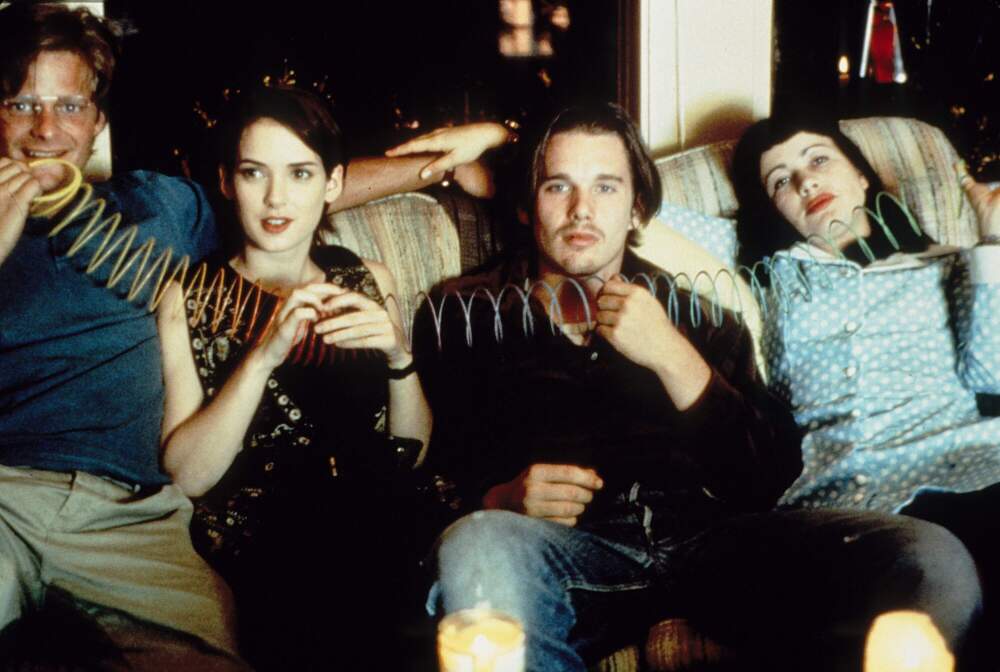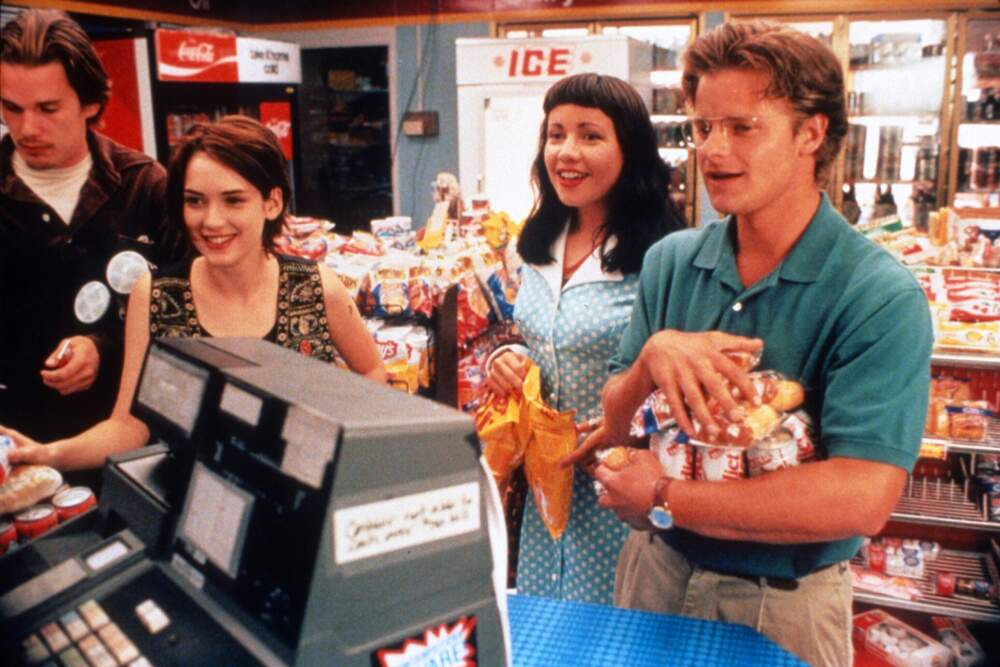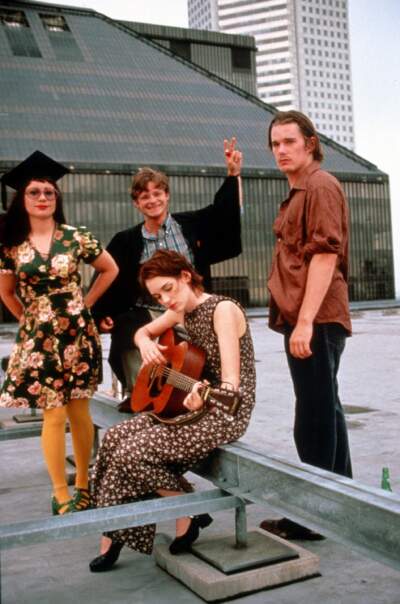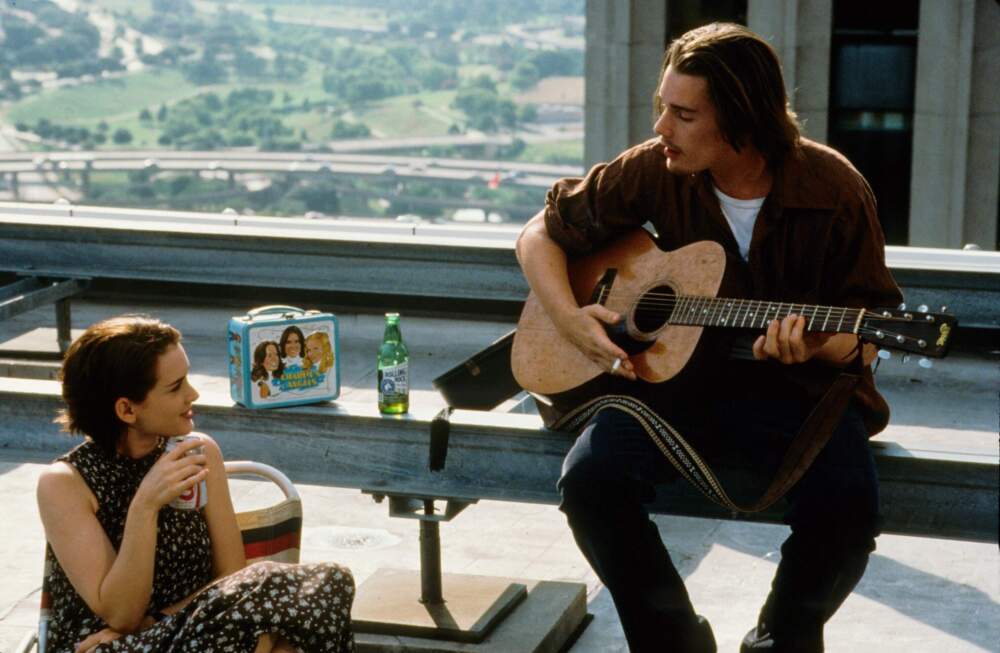Advertisement
Commentary
Revisiting seminal Gen X film 'Reality Bites' 30 years later

For a lot of us Gen Xers, watching “Reality Bites” now is like looking at an awkward yearbook picture of yourself when you had your worst haircut. Sure, it’s kind of cute, but mostly embarrassing and probably better left on the shelf. Released in February of 1994, the film underperformed at the box office yet occupies an oversized spot in the cultural memory of a certain era, no doubt thanks to a briefly ubiquitous soundtrack album that powered endless video rentals and cable airings. (Lisa Loeb’s closing credits track “Stay” was the first song by an unsigned artist to hit No. 1 on the Billboard chart, which when you think about it is like the most ‘90s thing ever.) “Reality Bites” is back on the big screen this week showing on 35mm as part of the Coolidge Corner Theatre’s Cinema Jukebox series, and seeing it again now that I’m the same age my parents were when it was released certainly offers some new angles on a seminal so-called youth picture.
Hotly hyped as the first Hollywood movie about the then-mysterious “Generation X,” the film followed Richard Linklater’s “Slacker” and predated Kevin Smith’s “Clerks” in the cinematic chronicles of the underemployed children of baby boomers, profiled in endless magazine think-pieces as commitment-phobic latchkey kids raised by television reruns who rejected the values of the Reagan era via a bored skepticism often interpreted as apathy. “Reality Bites” begins with lo-fi video of Winona Ryder’s valedictorian Lelaina Pierce ranting in her college commencement address about watching our parents’ generation “disembowel their revolution for a pair of running shoes,” before misplacing the last page of her speech. Still, her point remains that the boomers ended an unjust war, then became yuppie Republicans who got rich and ruined the world. This is why when I was growing up it was considered cooler not to care.
I was 19 years old when “Reality Bites” came out, and — after an advance campus screening — I found myself convinced that the film was “The Graduate” for our generation, dragging my parents along to see it a few weeks later so they could better understand the struggles faced by people my age trying to live authentically in a compromised world. They must have thought I was out of my mind. My folks politely disliked the film, but it took another couple of viewings for me to realize that “Reality Bites” actually isn’t very good, and what I was really responding to was seeing people who looked and sounded like me and my friends making familiar cultural references and complaining about the same stuff. Identification is a hell of a drug. (I’d get an even more powerful dose of it when “Clerks” came out that fall, a much funnier film that still rings painfully true for anyone who ever did time behind a cash register.)

Aspiring poet Helen Childress wrote “Reality Bites” when she was 20 years old, basing the script on the misadventures of college friends graduating into the dismal job market of the first Bush recession. It was originally an ensemble piece, but director Ben Stiller worked with her over a reported 70 drafts (!!) to hone the story into a more conventional love triangle, in which Ryder’s wannabe documentarian Lelaina must choose between Stiller’s uptight television executive Michael Grates and Ethan Hawke’s grungy bohemian Troy Dyer. Michael wears expensive Italian suits and is unfailingly kind and supportive. Boorish, unemployed Troy insults her all the time and looks like he smells. Naturally, Lelaina winds up with Troy, because even if he’s an a-hole who doesn’t have a job or any ambitions, Troy’s authentic to himself, which was something to aspire to back then. Michael might be a much nicer guy but he’s also the worst thing you could possibly be as a 20-something in the 1990s. He’s a sellout.
I have no idea how this aspect of the picture might possibly play to today’s audiences, but we used to worry an awful lot about selling out. In his book “The Nineties,” critic Chuck Klosterman described “Reality Bites” as “an instruction manual for a transitory set of values that only made sense in 1994.” Back then, the coolest celebrities treated their popularity as an affliction, and the only thing worse than being famous was wanting to be. Michael driving a sports car and working for a slick, MTV-like cable channel marked him immediately as the movie’s villain. In a modern age of Instagram influencers when seemingly everyone’s thirsty for likes and follows, the way Lelaina and Troy carry on about preserving their integrity must sound like alien transmissions from a distant solar system that burned out lightyears ago.
Of course, it doesn’t help that Troy is an insufferable ass. Played too well by Hawke in a role that would stick to him like gum on the bottom of his shoe for the next decade or so, the stringy-haired pretentious guy with a goatee in a thrift store shirt became a generational archetype, one Hawke also embodied in ‘90s-set literary adaptations like Alfonso Cuarón’s “Great Expectations” and Michael Almereyda’s “Hamlet” (to name two time capsules that have aged considerably better than “Reality Bites”). For a long time, I thought I hated Ethan Hawke, but I think I really just hated Troy. To his credit, the actor explored and deepened that persona considerably in the “Before” sequels he co-wrote with Richard Linklater and Julie Delpy, as well as Linklater’s “Boyhood,” in which Hawke plays a Troy-like hipster dad mellowing into middle age. In recent years, he’s become one of my favorite working actors, with a career that now seems like a model of how to survive in show business while keeping your indie cred intact.

But a couple of years after “Reality Bites” came out, some girls I knew in college spotted Hawke having lunch in Greenwich Village with the far less famous actor Frank Whaley, a regular in Oliver Stone’s stock company who’s these days probably best known for getting shot by John Travolta and Samuel L. Jackson at the beginning of “Pulp Fiction.” The gals nervously approached the table, and as Hawke prepared to greet them, they suddenly started shrieking that they couldn’t believe they were in the same restaurant as Frank Whaley, fawning all over him and asking for autographs. Pretending that they didn’t recognize Hawke, the girls handed him a camera and asked if he could take a picture of them with his lunch companion. It’s kind of a cruel prank, but I think a lot of us back then had the actor himself confused with Troy. (So toxic was the character that the real-life Troy Dyer, a former classmate of Childress’ at USC, sued her and the film’s producers for defamation. The case was settled out of court.)
When he made “Reality Bites,” first-time director Stiller had only a twice-failed sketch comedy show under his belt, bootleg VHS tapes of which were passed around among my circle of friends like precious contraband. “The Ben Stiller Show” had the dubious honor of being canceled by both MTV and the Fox Network after a single season apiece while introducing the world to cast members Janeane Garofalo, Andy Dick and Bob Odenkirk. The crazily specific parodies on the program were the work of an especially attentive lunacy. Son of comedy legends Jerry Stiller and Anne Meara, Stiller was a second-generation showbiz kid who once described himself as profoundly damaged by pop culture. His infamous (and very funny) flop “The Cable Guy” was all about how being raised on television turns you into a psychopath, while his outrageous “Tropic Thunder” skewered the celebrity brain damage that results from Hollywood’s reality distortion field. Sadly, Stiller has squandered most of his career playing an anodyne nebbish in hacky franchise comedies that would have been the subjects of savage satire on his original show. So maybe he was telling us something when he cast himself as the sellout?
It might be impossible to explain the extent to which Winona Ryder was everything to us boys back then. I’d first fallen for her in the scandalous suicide comedy “Heathers,” which was technically released in 1988 but feels like the first of what we now think of as “a ‘90s movie” in its violent, ironic sensibility and postmodern upending of teensploitation tropes. A winsome waif who carried herself like a tomboy, Ryder was the goddaughter of LSD guru Timothy Leary and was friends with J.D. Salinger while dating guys in all the coolest rock bands. Her delicate features made this quintessentially ‘90s It Girl perfect for period pieces, and “Reality Bites” fell between her career-topping roles in Martin Scorsese’s “The Age of Innocence” and Gillian Armstrong’s “Little Women.” The star later said she signed on to the project because she desperately wanted to do a movie in which she could wear jeans.
Ryder is incandescent in the picture, her crooked smile carrying scenes that barely exist on the page. She’s got a killer comic rapport with roommate Vickie, played by Garofalo in her first major movie role. Friend and frequent collaborator Stiller actually fired Garofalo during rehearsals for what the comedian has called her lousy work ethic and she was only rehired after Ryder intervened. (The studio wanted some nobody named Gwyneth Paltrow for the part.) The kind of girl who cuts her own bangs, wears babydoll dresses and carries a lunchbox for a purse, the proudly promiscuous Vickie is a classic, movie-stealing sidekick, and right away I found her intensely attractive because she seemed like someone who would be really mean to me. (Three years later, I interviewed Garofalo for the NYU paper and she couldn’t have been nicer, which was almost disappointing.)

She gets short shrift by an underdeveloped AIDS-scare subplot that nonetheless leads to the movie’s best scene: Vickie describes feeling like a guest star on a very special episode of Fox’s tawdry nighttime soap “Melrose Place” where her character teaches everyone important lessons about HIV and then they’ll all be wearing halter tops and choker chains at her funeral. The movie’s better riffs — there’s another AIDS-related doozy about “The Brady Bunch” — zero in on how these emotionally stunted kids only seem able to express themselves through pop culture references, culminating in the Stiller character’s climactic mangling of a passage from “Hamlet” to Hawke, himself a future melancholy Dane.
Indeed, the most fondly remembered parts of the movie, like Garofalo and Ryder singing along in the car to Squeeze or a drinking game devoted to the Norman Lear sitcom “Good Times,” involve communal celebrations of shared cultural memories. The most famous scene in the picture is when our gang gets stoned and dances to The Knack’s “My Sharona” (pro-tip: you can also sing the chorus as “My Winona”) while buying junk food at a mini-mart under an impossibly starry Texas sky. A distractingly pretty movie, “Reality Bites” was the first Hollywood film shot by now-legendary cinematographer Emmanuel Lubezski, who would go on to change the way modern movies look with Cuarón’s “Children of Men” and Terrence Malick’s “The Tree of Life.” He was in his golden backlighting phase here, with every strand of Ryder’s shaggy bob haircut granted its own ethereal halo. A montage of her pumping gas looks like a Rembrandt.
With 30 years of hindsight, it is rather humiliating that I even briefly took seriously a major studio film that preaches against selling out to big corporations while featuring extensive product placement for Pizza Hut and the Gap. There’s even a moment in which Ryder talks about wanting to keep her art pure while angling a Big Gulp so that the logo stays in the shot. Yet as quaint as such concerns may seem now, whenever I see my niece watching unboxing videos online or scroll by sponsored social media posts by millionaires, I find myself feeling like something important has been lost. Maybe there should still be some shame in being a shill? Looking at artists I admire like Ben Affleck and Matt Damon — both richer than Croesus yet clowning around in those stupid Dunkin’ Donuts outfits for cash they couldn’t possibly need — I can’t help but think less of them. Is this just a generational thing? Am I an old man yelling at a cloud in our “get that bag” culture? Troy Dyer may have been a jerk, but I’m not sure he was wrong.
“Reality Bites” screens at the Coolidge Corner Theatre on Thursday, April 25.
